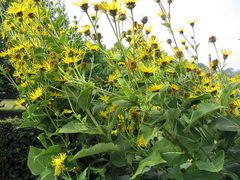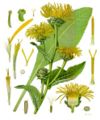Elecampane: Difference between revisions
No edit summary |
No edit summary |
||
| (One intermediate revision by one other user not shown) | |||
| Line 1: | Line 1: | ||
{{ | {{SPlantbox | ||
| | |familia=Asteraceae | ||
| | |genus=Inula | ||
| | |species=helenium | ||
| | |taxo_author=L. | ||
| | |common_name=Elecampane | ||
| | |Temp Metric=°F | ||
| | |jumpin=If this plant info box on watering; zones; height; etc. is mostly empty you can click on the edit tab and fill in the blanks! | ||
| | |image=Inule helenium.jpg | ||
|image_width=240 | |||
| | |||
}} | }} | ||
'''Elecampane''', also called '''Horse-heal''' (''Inula helenium'') or '''Marchalan''' (in [[Welsh language|Welsh]]), is a [[Perennial plant|perennial]] [[composite plant]] common in many parts of [[Great Britain]], and ranges throughout central and [[Southern Europe]], and in [[Asia]] as far eastwards as the [[Himalayas]]. | |||
It is a rather rigid [[herb]], the [[Plant stem|stem]] of which attains a height of from 3 to 5 feet; the [[leaves]] are large and toothed, the lower ones stalked, the rest embracing the stem; the [[flower]]s are yellow, 2 inches broad, and have many rays, each three-notched at the extremity. The root is thick, branching and mucilaginous, and has a warm, bitter taste and a [[camphoraceous]] [[odor]]. | |||
{{Inc| | |||
Inula helenium, Linn. Elecampane. Tall, thick-stemmed: lvs. unequally dentate-serrate; root- lvs. elliptic-oblong, narrowed into a petiole; st.-lvs. half-clasping, cordate-oblong: outer involucral parts leafy, ovate. Wet, sandy and mountainous regions. Eu., N. Asia. Naturalized in Amer. — The roots are thick and carrot-like. For medicinal purposes, 2-year- old roots should be dug in Aug. lf older, they are likely to be stringy and woody. | |||
}} | |||
==Cultivation== | |||
===Propagation=== | |||
===Pests and diseases=== | |||
==Varieties== | |||
==Gallery== | |||
== | |||
= | <gallery perrow=5> | ||
File:Koeh-210.jpg| | |||
Image:Upload.png| photo 1 | |||
Image:Upload.png| photo 2 | |||
Image:Upload.png| photo 3 | |||
</gallery> | |||
==References== | ==References== | ||
<references/> | <references/> | ||
*[[Standard Cyclopedia of Horticulture]], by L. H. Bailey, MacMillan Co., 1963 | |||
{{ | <!--- xxxxx *Flora: The Gardener's Bible, by Sean Hogan. Global Book Publishing, 2003. ISBN 0881925381 --> | ||
<!--- xxxxx *American Horticultural Society: A-Z Encyclopedia of Garden Plants, by Christopher Brickell, Judith D. Zuk. 1996. ISBN 0789419432 --> | |||
<!--- xxxxx *Sunset National Garden Book. Sunset Books, Inc., 1997. ISBN 0376038608 --> | |||
==External links== | |||
*{{wplink}} | |||
{{stub}} | |||
__NOTOC__ | |||
Latest revision as of 20:46, 18 March 2010
| Inula helenium subsp. var. | Elecampane | |||||||||||||||||||||||||||||||||||||||||||||||||||||||
|---|---|---|---|---|---|---|---|---|---|---|---|---|---|---|---|---|---|---|---|---|---|---|---|---|---|---|---|---|---|---|---|---|---|---|---|---|---|---|---|---|---|---|---|---|---|---|---|---|---|---|---|---|---|---|---|---|

|
|
| ||||||||||||||||||||||||||||||||||||||||||||||||||||||
| ||||||||||||||||||||||||||||||||||||||||||||||||||||||||
Elecampane, also called Horse-heal (Inula helenium) or Marchalan (in Welsh), is a perennial composite plant common in many parts of Great Britain, and ranges throughout central and Southern Europe, and in Asia as far eastwards as the Himalayas.
It is a rather rigid herb, the stem of which attains a height of from 3 to 5 feet; the leaves are large and toothed, the lower ones stalked, the rest embracing the stem; the flowers are yellow, 2 inches broad, and have many rays, each three-notched at the extremity. The root is thick, branching and mucilaginous, and has a warm, bitter taste and a camphoraceous odor.
| Standard Cyclopedia of Horticulture |
|---|
|
Inula helenium, Linn. Elecampane. Tall, thick-stemmed: lvs. unequally dentate-serrate; root- lvs. elliptic-oblong, narrowed into a petiole; st.-lvs. half-clasping, cordate-oblong: outer involucral parts leafy, ovate. Wet, sandy and mountainous regions. Eu., N. Asia. Naturalized in Amer. — The roots are thick and carrot-like. For medicinal purposes, 2-year- old roots should be dug in Aug. lf older, they are likely to be stringy and woody.
|
Cultivation
Propagation
Pests and diseases
Varieties
Gallery
-
photo 1
-
photo 2
-
photo 3
References
- Standard Cyclopedia of Horticulture, by L. H. Bailey, MacMillan Co., 1963
External links
- w:Elecampane. Some of the material on this page may be from Wikipedia, under the Creative Commons license.
- Elecampane QR Code (Size 50, 100, 200, 500)

